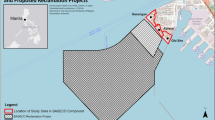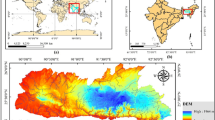Abstract
Karanganyar and the surrounding area are situated in a dynamic volcanic arc region, where landslide frequently occurs during the rainy season. The rain-induced landslide disasters have been resulting in 65 fatalities and a substantial socioeconomical loss in last December 2007. Again, in early February 2009, 6 more people died, hundreds of people temporary evacuated and tens of houses damaged due to the rain-induced landslide. Accordingly, inter-disciplinary approach for geological, geotechnical and social investigations were undertaken with the goal for improving community resilience in the landslide vulnerable villages. Landslide hazard mapping and community-based landslide mitigation were conducted to reduce the risk of landslides. The hazard mapping was carried out based on the susceptibility assessment with respect to the conditions of slope inclination, types and engineering properties of lithology/soil as well as the types of landuse. All of those parameters were analyzed by applying weighing and scoring system which were calculated by semi qualitative approach (Analytical Hierarchical Process). It was found that the weathered andesitic-steep slope (steeper than 30o) was identified as the highest susceptible slope for rapid landslide, whilst the gentle colluvial slope with inter-stratification of tuffaceous clay-silt was found to be the susceptible slope for creeping. Finally, a programme for landslide risk reduction and control were developed with special emphasize on community-based landslide mitigation and early warning system. It should be highlighted that the social approach needs to be properly addressed in order to guarantee the effectiveness of landslide risk reduction.
Similar content being viewed by others
References
Cruden DM, Varnes DJ (1996) Landslide types and processess. In: Turner AK et al. (eds.), Special Report 247: Landslides: Investigation and Mitigation. TRB, National Research Council, Washington D.C, pp 36–75
Fathani TF, Karnawati D, Sassa K, Fukuoka H (2008) Development of landslide monitoring and early warning system in Indonesia. In: Proceeding of the First World Landslide Forum, 18–21 Nov. 2008. United Nation University, Tokyo, Japan. Global Promotion Committee of the Int. Program on Landslide (IPL) — ISDR, pp 195–198
Japan Landslide Society (1996) Landslides in Japan (The Fifth Revision). National Conference of Landslide Control
Karnawati D (1996). Mechanism of Rain-Induced Landsliding in Allophanic and Halloysitic Soils in Java. Ph.D Dissertation. Leeds University, UK. Unpublished
Karnawati D, Fathani TF, Burton PW (2008) Seismic and Landslide Hazard Mapping for Community Empowerment. Report of Development of Partnership in Higher Education Program. The British Council. Unpublished.
Karnawati D, Fathani TF, Andayani B, Burton PW, Suharto (2009) Strategic program for landslide disaster risk reduction; a lesson learned from Central Java, Indonesia. In: Duncan K et al. (eds.), Disaster Management and Human Health Risk; Reducing Risk, Improving Outcomes. WIT Transactions on the Built Environment, WIT Press, Southampton, UK, pp 115–126
Saaty TL (1980) The Analytical Hierarchy process. McGraw-Hill. New York
Su Su Ky (2007). The Scoring System for Landslide Risk Microzonation and the Mechanism of Weathered Tuff Layer in the Landslide Phenomena of Tropical Volcanic Area, Yogyakarta, Indonesia. Ph.D Dissertation. Gadjah Mada University, Indonesia. Unpublished
Wu TH, Tang WH, Einstein HH (1996) Landslide Hazard and Risk Assessment. In: Turner AK et al. (eds.), Special Report 247: Landslides: Investigation and Mitigation. TRB, National Research Council, Washington
Author information
Authors and Affiliations
Corresponding author
Rights and permissions
About this article
Cite this article
Karnawati, D., Fathani, T.F., Ignatius, S. et al. Landslide hazard and community-based risk reduction effort in Karanganyar and the surrounding area, central Java, Indonesia. J. Mt. Sci. 8, 149–153 (2011). https://doi.org/10.1007/s11629-011-2107-6
Received:
Accepted:
Published:
Issue Date:
DOI: https://doi.org/10.1007/s11629-011-2107-6




